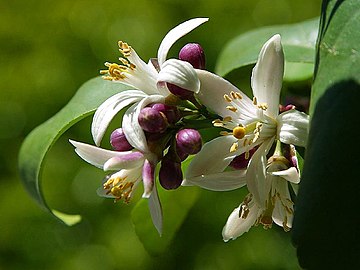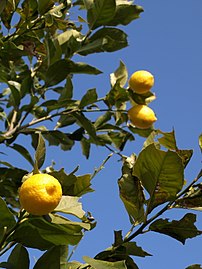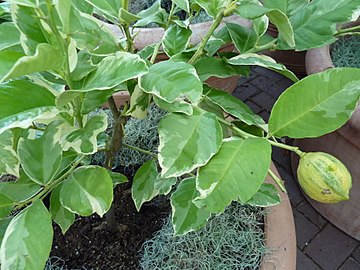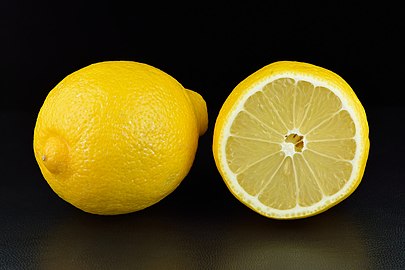Lemon
| Lemon | |
|---|---|

| |
| A fruiting lemon tree (blossom visible) | |
| Scientific classification | |
| Kingdom: | Plantae |
| Clade: | Tracheophytes |
| Clade: | Angiosperms |
| Clade: | Eudicots |
| Clade: | Rosids |
| Order: | Sapindales |
| Family: | Rutaceae |
| Genus: | Citrus |
| Species: | C.×limon
|
| Binomial name | |
| Citrus×limon | |
| Synonyms[1] | |
|
List
| |
Thelemon(Citrus×limon) is aspeciesof smallevergreentree in theflowering plantfamilyRutaceae,native toAsia,primarilyNortheast India(Assam), Northern Myanmar, and China.[2]
The tree'sellipsoidalyellowfruitis used for culinary and non-culinary purposes throughout the world, primarily for itsjuice,which has both culinary and cleaning uses.[2]The pulp andrindare also used in cooking and baking. The juice of the lemon is about 5–6%citric acid,[citation needed]with apHof around 2.2,[3]giving it a sour taste. The distinctive sour taste of lemon juice, derived from the citric acid, makes it a key ingredient indrinksand foods[4]such aslemonadeandlemon meringue pie.
Description
The lemon tree produces anellipsoidalyellowfruit.
-
Lemon seedling
-
Full-sized tree
-
Flower
-
Lemon with leaves
-
Lemon cidra
-
Mature lemons
-
Variegatedpink lemon
Chemistry
Lemons contain numerousphytochemicals,includingpolyphenols,terpenes,andtannins.[5]Lemon juice contains slightly morecitric acidthanlimejuice (about 47 g/L), nearly twice the citric acid ofgrapefruitjuice, and about five times the amount of citric acid found inorangejuice.[6]
Taxonomy

The origin of the lemon is unknown, though lemons are thought to have first grown inAssam(a region innortheast India), northernMyanmar,orChina.[2][failed verification]A genomic study of the lemon indicated it was a hybrid betweenbitter orange(sour orange) andcitron.[7][8]
The origin of the wordlemonmay be Middle Eastern.[2]The word draws from the Old Frenchlimon,then Italianlimone,from the Arabiclaymūnorlīmūn,and from thePersianlīmūn,a generic term forcitrusfruit, which is a cognate of Sanskrit (nimbū,'lime').[9]
Varieties
The 'Bonnie Brae' is oblong, smooth, thin-skinned, and seedless.[10]These are mostly grown inSan Diego County,US.[11]
The 'Eureka' grows year-round and abundantly. This is the common supermarket lemon, also known as "Four Seasons" (Quatre Saisons) because of its ability to produce fruit and flowers together throughout the year. This variety is also available as a plant for domestic customers.[12]There is also apink-fleshed Eureka lemonwith a green and yellowvariegatedouter skin.[13]
The Lisbon lemon is very similar to the Eureka and is the other common supermarket lemon. It is smoother than the Eureka, has thinner skin, and has fewer or no seeds. It generally produces more juice than the Eureka.[14][15]
The 'Femminello St. Teresa', or 'Sorrento'[16]originates in Italy. This fruit'szestis high in lemon oils. It is the variety traditionally used in the making oflimoncello.
The 'Yen Ben' is an Australasian cultivar.[17]
Cultivation
History
Lemons are supposed to have enteredEuropenear southernItalyno later than the second century AD, during the time ofAncient Rome.[2]They were later introduced toPersiaand then toIraqandEgyptaround 700 AD.[2]The lemon was first recorded in literature in a 10th-centuryArabictreatise on farming and was also used as an ornamental plant in earlyIslamic gardens.[2]It was distributed widely throughout the Arab world and theMediterranean regionbetween 1000 and 1150.[2]An article on Lemon and lime tree cultivation inAndalusia,Spain,is brought down inIbn al-'Awwam's 12th-century agricultural work,Book on Agriculture.[18]
The first substantial cultivation of lemons in Europe began inGenoain the middle of the 15th century. The lemon was later introduced to theAmericasin 1493, whenChristopher Columbusbrought lemon seeds toHispaniolaon his voyages. Spanish conquest throughout the New World helped spread lemon seeds. It was mainly used as an ornamental plant and for medicine.[2]In the 19th century, lemons were increasingly planted inFloridaandCalifornia.[2]
In 1747,James Lind's experiments on seamen suffering fromscurvyinvolved adding lemon juice to their diets, thoughvitamin Cwas not yet known as an important dietary ingredient.[2][19]
Propagation
| Lemon (and lime) production, 2022
millions of tonnes | |
|---|---|
| Country | 2022 |
| 3.8 | |
| 3.1 | |
| 2.6 | |
| 1.8 | |
| 1.6 | |
| 1.3 | |
| World | 21.5 |
| Source:FAOSTATof the United Nations.[20] | |
Lemons need a minimum temperature of around 7 °C (45 °F), so they are not hardy year-round in temperate climates, but become hardier as they mature.[21]Citrus require minimal pruning by trimming overcrowded branches, with the tallest branch cut back to encourage bushy growth.[21]Throughout summer, pinching back tips of the most vigorous growth assures more abundant canopy development. As mature plants may produce unwanted, fast-growing shoots (called "water shoots" ), these are removed from the main branches at the bottom or middle of the plant.[21]
There is reputed merit in the tradition ofurinatingnear a lemon tree.[22][23]
In cultivation in theUK,the cultivars "Meyer"[24] and "Variegata"[25] have gained theRoyal Horticultural Society'sAward of Garden Merit(confirmed 2017).[26]
Production
In 2022, world production of lemons (combined withlimesfor reporting) was 22 milliontonnesled by India with 18% of the total. Mexico and China were major secondary producers (table).
| Nutritional value per 100 g (3.5 oz) | |
|---|---|
| Energy | 121 kJ (29 kcal) |
9.32 g | |
| Sugars | 2.5 g |
| Dietary fiber | 2.8 g |
0.3 g | |
1.1 g | |
| Vitamins | Quantity %DV† |
| Thiamine (B1) | 3% 0.04 mg |
| Riboflavin (B2) | 2% 0.02 mg |
| Niacin (B3) | 1% 0.1 mg |
| Pantothenic acid (B5) | 4% 0.19 mg |
| Vitamin B6 | 5% 0.08 mg |
| Folate (B9) | 3% 11 μg |
| Choline | 1% 5.1 mg |
| Vitamin C | 59% 53 mg |
| Minerals | Quantity %DV† |
| Calcium | 2% 26 mg |
| Iron | 3% 0.6 mg |
| Magnesium | 2% 8 mg |
| Manganese | 1% 0.03 mg |
| Phosphorus | 1% 16 mg |
| Potassium | 5% 138 mg |
| Zinc | 1% 0.06 mg |
| †Percentages estimated usingUS recommendationsfor adults,[27]except for potassium, which is estimated based on expert recommendation fromthe National Academies.[28] | |
Uses
Nutrition
Lemon is a rich source ofvitamin C,providing 64% of theDaily Valuein a 100 g reference amount (table). Otheressential nutrientsare low in content.
Culinary
Lemon juice, rind, and peel are used in a wide variety of foods and drinks. The whole lemon is used to makemarmalade,lemon curdandlemon liqueur.Lemon slices and lemon rind are used as agarnishfor food and drinks. Lemonzest,the grated outer rind of the fruit, is used to add flavor to baked goods, puddings, rice, and other dishes.
Juice
Lemon juice is used to makelemonade,soft drinks,andcocktails.It is used inmarinadesfor fish, where its acid neutralizesaminesin fish by converting them into nonvolatileammoniumsalts. In meat, the acid partiallyhydrolyzestough collagen fibers,tenderizingit.[29]In theUnited Kingdom,lemon juice is frequently added topancakes,especially onShrove Tuesday.
Lemon juice is also used as a short-termpreservativeon certain foods that tend to oxidize and turn brown after being sliced (enzymatic browning), such asapples,bananas,andavocados,where its acid denatures the enzymes.
Peel
InMorocco,lemons are preserved in jars or barrels of salt. The salt penetrates the peel and rind, softening them, and curing them so that they last almost indefinitely.[30]The preserved lemon is used in a wide variety of dishes. Preserved lemons can also be found in Sicilian, Italian, Greek, and French dishes.
The peel can be used in the manufacture ofpectin,a polysaccharide used as a gelling agent and stabilizer in food and other products.[31]
Oil
Lemon oil is extracted from oil-containing cells in the skin. A machine breaks up the cells and uses a water spray to flush off the oil. The oil–water mixture is then filtered and separated bycentrifugation.[32]
Leaves
The leaves of the lemon tree are used to make a tea and for preparing cooked meats and seafoods.
Other uses
Industrial
Lemons were the primary commercial source ofcitric acidbefore the development offermentation-based processes.[33]
Aroma
Lemon oil may be used inaromatherapy.Lemon oil aroma does not influence the humanimmune system,[34]but may contribute to relaxation.[35]
Other
One educational science experiment involves attachingelectrodesto a lemon and using it as abatteryto produce electricity. Although very low power, severallemon batteriescan power a small digital watch.[36]These experiments also work with other fruits and vegetables.
Lemon juice may be used as a simpleinvisible ink,developed by heat.[37]
Lemon juice can be used to increase theblondecolour of hair, acting as a natural highlight after the moistened hair is exposed to sunlight. This is due to the citric acid that acts as bleach.[38][39]
Other citrus called "lemons"
- Flat lemon,a mandarin hybrid.[40]
- Meyer lemon,a cross between a citron and a mandarin/pomelo hybrid distinct from sour or sweet orange,[41]named after Frank N. Meyer, who first introduced it to the United States in 1908. Thin-skinned and slightly less acidic than the Lisbon and Eureka lemons, Meyer lemons require more care when shipping and are not widely grown on a commercial basis. Meyer lemons often mature to a yellow-orange color. They are slightly more frost tolerant.
- Ponderosa lemon,more cold-sensitive than true lemons, the fruit are thick-skinned and very large. Genetic analysis showed it to be a complex hybrid of citron and pomelo.[41]
- Rough lemon,a citron-mandarin cross, cold-hardy and often used as acitrus rootstock[41]
- Sweet lemonsor sweet limes, a mixed group including thelumia(pear lemon),limetta,andPalestinian sweet lime.Among them is the Jaffa lemon, a pomelo-citron hybrid.[41]
- Volkamer lemon,like the rough lemon, a citron-mandarin cross[41]

In culture
This sectionneeds expansion.You can help byadding to it.(December 2023) |
InIndia,a lemon may be ritually encircled around a person due to the belief that it would repel negative energies or ward off theevil eye,callednazarordrishti.[42]It is also a common practice for owners of a new car to drive over four lemons, one under each wheel, crushing them during their first drive. This is believed to protect the driver from accidents.[43]
Hindu deitiesare sometimes depicted with lemons in theiriconography,representing the attribute of wealth or abundance.[44]
See also
References
- ^"Citrus limon(L.) Osbeck ".World Flora Online.The World Flora Online Consortium. 2022.Archivedfrom the original on March 14, 2024.RetrievedJuly 23,2022.
- ^abcdefghijkJulia F. Morton (1987)."Lemon in Fruits of Warm Climates".Purdue University. pp. 160–168.Archivedfrom the original on November 26, 2019.RetrievedDecember 18,2007.
- ^James N. Spencer; George M. Bodner; Lyman H. Rickard (2010).Chemistry: Structure and Dynamics.John Wiley & Sons. p. 481.ISBN9780470920930.Archivedfrom the original on October 4, 2023.RetrievedAugust 22,2023.
- ^Comprehensive Natural Products II: Chemistry and Biology.Elsevier. 2010.ISBN9780080453828.Archivedfrom the original on October 4, 2023.RetrievedAugust 22,2023.
- ^Rauf A, Uddin G, Ali J (2014)."Phytochemical analysis and radical scavenging profile of juices ofCitrus sinensis,Citrus aurantifolia,andCitrus limonum".Org Med Chem Lett.4:5.doi:10.1186/2191-2858-4-5.PMC4091952.PMID25024932.
- ^Penniston KL, Nakada SY, Holmes RP, Assimos DG (2008)."Quantitative Assessment of Citric Acid in Lemon Juice, Lime Juice, and Commercially-Available Fruit Juice Products".Journal of Endourology.22(3): 567–570.doi:10.1089/end.2007.0304.PMC2637791.PMID18290732.
- ^Gulsen, O.; M. L. Roose (2001)."Lemons: Diversity and Relationships with SelectedCitrusGenotypes as Measured with Nuclear Genome Markers ".Journal of the American Society for Horticultural Science.126(3): 309–317.doi:10.21273/JASHS.126.3.309.
- ^Genetic origin of cultivated citrus determined: Researchers find evidence of origins of orange, lime, lemon, grapefruit, other citrus species "ArchivedSeptember 21, 2017, at theWayback Machine,Science Daily,January 26, 2011 (Retrieved February 10, 2017).
- ^Douglas Harper."Online Etymology Dictionary".Archivedfrom the original on August 6, 2011.RetrievedMay 13,2012.
- ^Spalding, William A. (1885).The orange: its culture in California.Riverside,California: Press and Horticulturist Steam Print. p.88.RetrievedMarch 2,2012.
Bonnie Brae lemon.
- ^Carque, Otto (2006) [1923].Rational Diet: An Advanced Treatise on the Food Question.Los Angeles,California:Kessinger Publishing.p. 195.ISBN978-1-4286-4244-7.Archivedfrom the original on March 14, 2024.RetrievedMarch 2,2012.
- ^Buchan, Ursula (January 22, 2005)."Kitchen garden: lemon tree".The Daily Telegraph.London.Archivedfrom the original on March 13, 2014.RetrievedJanuary 24,2014.
- ^Vaiegated pinkArchivedDecember 1, 2017, at theWayback Machineat theCitrus Variety Collection.
- ^"frostlisbon".citrusvariety.ucr.edu.Archivedfrom the original on November 6, 2020.RetrievedSeptember 27,2020.
- ^says, 3 Easy Tips: How to Plant Lemon Seeds at Home Indoors or Outdoors (February 1, 2007)."Eureka Lemon and Lisbon Lemon: Kitchen Basics".Harvest to Table.Archivedfrom the original on November 6, 2020.RetrievedSeptember 27,2020.
{{cite web}}:CS1 maint: numeric names: authors list (link) - ^"Taste of a thousand lemons".Los Angeles Times.September 8, 2004.Archivedfrom the original on December 22, 2013.RetrievedNovember 21,2011.
- ^"New Zealand Citrus".ceventura.ucdavis.edu. Archived fromthe originalon June 10, 2010.RetrievedJune 13,2010.
- ^Ibn al-'Awwam, Yaḥyá(1864).Le livre de l'agriculture d'Ibn-al-Awam (kitab-al-felahah)(in French). Translated by J.-J. Clement-Mullet. Paris: A. Franck. pp. 300–301 (ch. 7 - Article 32).OCLC780050566.(pp.300–301 (Article XXXII)
- ^James Lind (1757).A treatise on the scurvy. Second edition.London: A. Millar.
- ^"World production of lemons and limes in 2022; Crops/Regions/World/Production Quantity/Year from pick lists".Food and Agriculture Organization of the United Nations, Statistics Division (FAOSTAT). 2024.RetrievedMarch 23,2024.
- ^abc"Citrus".Royal Horticultural Society. 2017.Archivedfrom the original on April 20, 2017.RetrievedApril 19,2017.
- ^Capomolla, Fabian; Pember, Matthew (2011). "Lemon".The Little Veggie Patch Co.Sydney, New South Wales: Plum. p. 129.ISBN9781742628417.Archivedfrom the original on March 14, 2024.RetrievedApril 27,2020.
Urinating around a lemon tree provides a tonic of water, salt and minerals, much like that of an organic fertiliser [...].
- ^Capomolla, Fabian (2017).Growing Food the Italian Way.The Hungry Gardener. Plum. p. 168.ISBN9781760554903.Archivedfrom the original on March 14, 2024.RetrievedApril 27,2020.
Yes, it is true - urinating on the soil around a lemon tree is beneficial to the plant. Just don't overdo it, as that can be detrimental.
- ^"RHS Plantfinder - Citrus × limon 'Meyer'".Archivedfrom the original on January 4, 2020.RetrievedJanuary 30,2018.
- ^"RHS Plantfinder - Citrus × limon 'Variegata'".Archivedfrom the original on December 30, 2019.RetrievedJanuary 30,2018.
- ^"AGM Plants - Ornamental"(PDF).Royal Horticultural Society. July 2017. p. 20.Archived(PDF)from the original on January 5, 2018.RetrievedJanuary 24,2018.
- ^United States Food and Drug Administration(2024)."Daily Value on the Nutrition and Supplement Facts Labels".FDA.Archivedfrom the original on March 27, 2024.RetrievedMarch 28,2024.
- ^National Academies of Sciences, Engineering, and Medicine; Health and Medicine Division; Food and Nutrition Board; Committee to Review the Dietary Reference Intakes for Sodium and Potassium (2019). Oria, Maria; Harrison, Meghan; Stallings, Virginia A. (eds.).Dietary Reference Intakes for Sodium and Potassium.The National Academies Collection: Reports funded by National Institutes of Health. Washington, DC: National Academies Press (US).ISBN978-0-309-48834-1.PMID30844154.Archivedfrom the original on May 9, 2024.RetrievedJune 21,2024.
- ^"Fruit enzymes tenderise meat".Science Learning Hub.Archivedfrom the original on May 23, 2020.RetrievedMay 14,2020.
- ^Moskin, Julia."Preserved Lemons Recipe".NYT Cooking.Archivedfrom the original on May 13, 2020.RetrievedMay 14,2020.
- ^Dimopoulou, Maria; Alba, Katerina; Campbell, Grant; Kontogiorgos, Vassilis (November 1, 2019). "Pectin recovery and characterization from lemon juice waste streams".Journal of the Science of Food and Agriculture.99(14): 6191–6198.Bibcode:2019JSFA...99.6191D.doi:10.1002/jsfa.9891.ISSN1097-0010.PMID31250441.S2CID195760607.
- ^Tranchida, Peter Quinto (2010), "Advanced Analytical Techniques for the Analysis of Citrus Oils",Citrus Oils,CRC Press, pp. 482–516,doi:10.1201/b10314-16,ISBN978-1-4398-0029-4
- ^M. Hofrichter (2010).Industrial Applications.Springer. p. 224.ISBN978-3-642-11458-8.
- ^Kiecolt-Glaser, J. K.; Graham, J. E.; Malarkey, W. B.; Porter, K; Lemeshow, S; Glaser, R (2008)."Olfactory influences on mood and autonomic, endocrine, and immune function".Psychoneuroendocrinology.33(3): 328–39.doi:10.1016/j.psyneuen.2007.11.015.PMC2278291.PMID18178322.
- ^Cooke, B; Ernst, E (2000)."Aromatherapy: A systematic review".British Journal of General Practice.50(455): 493–6.PMC1313734.PMID10962794.
- ^"Lemon Power".California Energy Commission. Archived fromthe originalon May 19, 2017.RetrievedDecember 7,2014.
- ^Mirsky, Steve (April 20, 2010)."Invisible Ink and More: The Science of Spying in the Revolutionary War".Scientific American.Archivedfrom the original on October 21, 2016.RetrievedOctober 15,2016.
- ^"Here's how to lighten your hair at home with lemon juice (it actually works)".Glamour UK.Bianca London. 2020.Archivedfrom the original on September 28, 2020.RetrievedSeptember 16,2020.
- ^"Does lemon juice really lighten hair?".Klorane Laboratories. 2020.Archivedfrom the original on January 22, 2022.RetrievedSeptember 18,2020.
- ^Yamamoto, Masashi; Takakura, Akiko; Tanabe, Aika; Teramoto, Sayuri; Kita, Masayuki (2017). "Diversity of Citrus depressa Hayata (Shiikuwasha) revealed by DNA analysis".Genetic Resources and Crop Evolution.64(4): 805–814.doi:10.1007/s10722-016-0403-2.S2CID35979614.
- ^abcdeCurk, Franck; Ollitrault, Frédérique; Garcia-Lor, Andres; Luro, François; Navarro, Luis; Ollitrault, Patrick (2016)."Phylogenetic origin of limes and lemons revealed by cytoplasmic and nuclear markers".Annals of Botany.11(4): 565–583.doi:10.1093/aob/mcw005.PMC4817432.PMID26944784.
- ^Amariglio, Jack; Cullenberg, Stephen E; Ruccio, David F (2013).Post-Modernism, Economics and Knowledge.Routledge. pp. 217–.ISBN978-1-134-83668-0.
- ^Leslie, Julia (1992).Roles and Rituals for Hindu Women.Motilal Banarsidass Publ. p. 116.ISBN978-81-208-1036-5.
- ^Pal, Pratapaditya; Canada, National Gallery of; Arts (Firm), Bayeux (1997).Divine Images, Human Visions: The Max Tanenbaum Collection of South Asian and Himalayan Art in the National Gallery of Canada.National Gallery of Canada. p. 41.ISBN978-1-896209-05-0.
External links
 Media related toCitrus × limonat Wikimedia Commons
Media related toCitrus × limonat Wikimedia Commons Data related toCitrus × limonat Wikispecies
Data related toCitrus × limonat Wikispecies- .Encyclopædia Britannica.Vol. 16 (11th ed.). 1911. pp. 413–415.(with illustrations)








